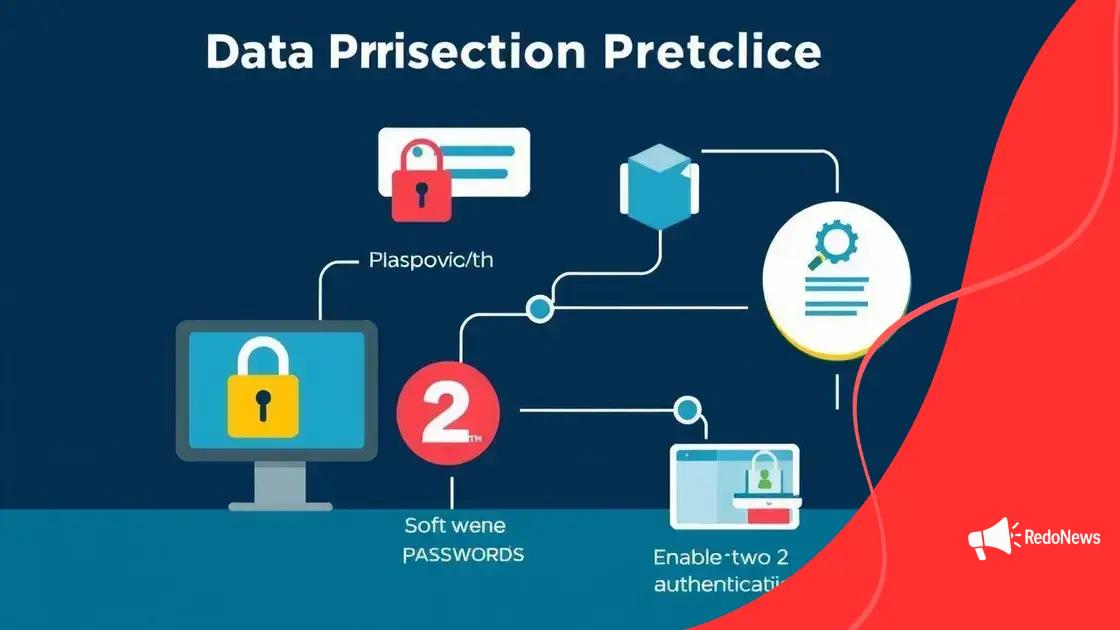Cybersecurity: Threats persist. What you need to know

Cybersecurity threats persist, evolving with tactics such as AI-driven attacks and sophisticated phishing, making it crucial for individuals and organizations to adopt robust defenses and stay informed about emerging trends.
Cybersecurity: Threats persist. In our increasingly digital world, understanding these threats is more important than ever. What steps can you take to safeguard your information?
Understanding the current cybersecurity landscape
In today’s digital age, understanding the current cybersecurity landscape is essential for everyone. Cyber threats are more prevalent than ever, making it crucial to recognize the various forms they take.
The explosion of the internet has greatly increased the vulnerability of personal and corporate data. As technology evolves, the tactics used by cybercriminals also advance, making it challenging to stay ahead.
Types of Cybersecurity Threats
There are several common cybersecurity threats that individuals and organizations must be aware of. These include:
- Malware: Malicious software such as viruses, worms, and spyware that can disrupt systems and steal information.
- Phishing: Deceptive emails or messages that trick users into providing sensitive information.
- Ransomware: A type of malware that locks your files until a ransom is paid.
- DDoS Attacks: Distributed Denial of Service attacks aim to overwhelm servers, resulting in downtime.
Each of these threats can have serious consequences, including financial loss and damage to reputation. It’s important to implement protective measures.
Importance of Staying Informed
Staying informed about the latest trends in cybersecurity can greatly enhance your ability to protect yourself and your organization. This means regularly checking for updates on security technologies and understanding emerging threats.
By actively educating yourself and investing in cybersecurity training, you can build a robust defense against potential attacks. Don’t underestimate the importance of being proactive rather than reactive.
As we continue to explore the complexities of cybersecurity, remember that awareness is one of your best tools. Keeping abreast of the latest developments can significantly reduce risks, ensuring that both personal and professional data remain safe from harm.
Common types of cybersecurity threats
Understanding the common types of cybersecurity threats is vital for anyone navigating today’s digital world. These threats can take various forms, targeting individuals and organizations alike.
One prevalent type of threat is malware. This includes viruses, worms, and spyware designed to harm or exploit devices and networks. Each type of malware has its own characteristics, but their goal is often to steal data or disrupt functionality.
Phishing Attacks
Phishing is another significant threat that involves deceptive emails or messages. Cybercriminals impersonate trusted sources to trick users into revealing sensitive information, like passwords or credit card numbers. Phishing attacks have become increasingly sophisticated, making it essential to recognize their signs.
Ransomware
A particularly dangerous form of malware is ransomware. This malicious software encrypts files on a victim’s computer, demanding payment before access is restored. Ransomware can cripple businesses, leading to significant financial losses and data breaches.
Denial of Service Attacks
Many companies also face threats from DDoS attacks (Distributed Denial of Service). Attackers overwhelm a server with traffic, causing downtime and disrupting services. These attacks can harm reputations and customer trust.
Lastly, insider threats shouldn’t be overlooked. Current or former employees can pose risks by misusing their access to sensitive information. It’s crucial for organizations to monitor access and enforce strict security policies.
By learning about these cybersecurity threats, individuals and organizations can better protect themselves. Awareness allows for proactive measures to reduce vulnerability and enhance overall security.
Best practices for protecting your data

Implementing the best practices for protecting your data is essential in today’s digital landscape. With rising cybersecurity threats, safeguarding sensitive information should be a top priority.
One key practice is using strong, unique passwords. A combination of letters, numbers, and symbols makes it difficult for hackers to guess. It’s also wise to change your passwords regularly to maintain security.
Enable Two-Factor Authentication
Another effective measure is to enable two-factor authentication (2FA). This adds an extra layer of security by requiring a second form of verification, such as a text message code or an authentication app, in addition to your password.
Keep Software Updated
Regularly updating software is crucial. Updates often include security patches that protect against new threats. Set your devices to automatically update whenever possible.
Use Secure Networks
When accessing sensitive information, always use secure networks. Avoid public Wi-Fi for transactions or accessing personal accounts, as these networks can be less secure.
- Encrypt Sensitive Data: Encryption makes your data unreadable to unauthorized users.
- Back Up Data Regularly: Backing up ensures that you can restore your information in case of loss or corruption.
- Educate Yourself: Stay informed about the latest threats and security practices to enhance your protection.
Lastly, be cautious with emails and links. Phishing attacks often use fake emails to lure victims into providing personal information. Always verify the source before clicking on links or downloading attachments.
By following these best practices for protecting your data, you can significantly reduce your risk of falling victim to cyber threats and ensure your information remains safe.
The role of technology in cybersecurity defense
The role of technology in cybersecurity defense is critical in today’s increasingly digital world. As cyber threats grow more sophisticated, technology serves as a frontline defense that can protect sensitive information.
One significant advancement in cybersecurity is the use of artificial intelligence (AI). AI can analyze vast amounts of data quickly, identifying patterns that may indicate a security threat. This helps organizations respond faster to potential breaches.
Firewalls and Intrusion Detection Systems
Firewalls are essential tools that monitor and control incoming and outgoing network traffic based on predetermined security rules. They act as barriers between trusted internal networks and untrusted external networks.
Intrusion detection systems (IDS) enhance this protection by detecting suspicious activity within a network. They can automatically alert administrators of potential threats, thus preventing breaches before they escalate.
Encryption Technology
Another critical aspect of cybersecurity technology is encryption. This process converts data into a coded format that can only be read by authorized users. Encryption protects sensitive information, especially during transmission over public networks.
Furthermore, organizations are leveraging cloud computing solutions for better security management. Cloud providers often have advanced security measures in place, including encryption and regular security audits. This allows companies to focus on their core tasks while benefiting from robust security defences.
Regular Software Updates
Technological tools also include regular software updates. These updates often contain security patches that fix vulnerabilities, making it vital for organizations to stay current with their systems.
Finally, employee training plays a pivotal role alongside technology. Even the best systems can’t protect against human error. Training staff to recognize phishing attempts and secure practices can greatly reduce risks.
In summary, the synergy of modern technology in cybersecurity plays a vital role in defending against evolving threats, ensuring that systems remain secure and resilient.
Future trends in cybersecurity threats and defenses
As we look ahead, understanding the future trends in cybersecurity threats and defenses is crucial. The digital landscape is constantly evolving, making it important for individuals and organizations to stay informed.
One emerging trend is the rise of artificial intelligence in cyberattacks. Cybercriminals are using AI to create more sophisticated threats that can adapt and learn. This means traditional defenses may struggle to keep up.
Increased Phishing Attacks
Phishing attacks are likely to become even more prevalent. With advancements in technology, attackers can create emails and websites that look almost identical to legitimate ones. Users will need to be increasingly vigilant to recognize these scams.
Ransomware Evolution
Ransomware attacks are also expected to grow more complex. Attackers might target critical infrastructure, such as healthcare or utilities, demanding higher ransoms. Organizations will need to improve their security protocols to protect against these large-scale threats.
Rise of IoT Vulnerabilities
The proliferation of Internet of Things (IoT) devices presents new vulnerabilities. As more devices connect to the internet, the potential entry points for attacks increase. Manufacturers and users alike must prioritize security features in devices to mitigate risks.
- Zero Trust Security Model: This approach assumes that threats could exist both outside and inside the network, requiring strict verification for every connection.
- Cloud Security Improvements: As businesses continue to migrate to the cloud, enhancing cloud security features will be critical to protect sensitive data.
- Employee Training: Ongoing education on security practices will be vital, as human error remains a leading cause of breaches.
Emerging technologies such as blockchain offer potential defenses against cyberattacks. By providing secure, decentralized methods for transactions, blockchain could reduce risks associated with data breaches.
Staying ahead of these trends is essential for anyone involved in cybersecurity. By understanding the potential threats and developing appropriate defenses, we can better protect ourselves in this rapidly changing digital landscape.
FAQ – Frequently Asked Questions about Cybersecurity Threats and Defenses
What are the most common types of cybersecurity threats?
Common threats include malware, phishing attacks, ransomware, and denial of service attacks, each targeting individuals and organizations.
How can I protect my data from cyber threats?
Using strong passwords, enabling two-factor authentication, and regularly updating software are essential practices to safeguard your data.
Why is employee training important in cybersecurity?
Employee training helps staff recognize phishing attempts and understand security practices, reducing the risk of human error leading to breaches.
What future trends should I be aware of in cybersecurity?
Trends include increased AI usage in cyberattacks, more sophisticated ransomware, and vulnerabilities from IoT devices, among others.
